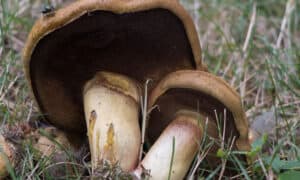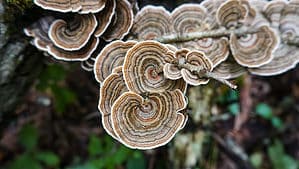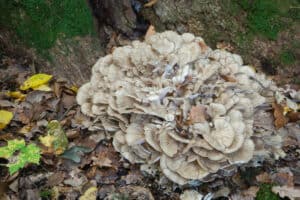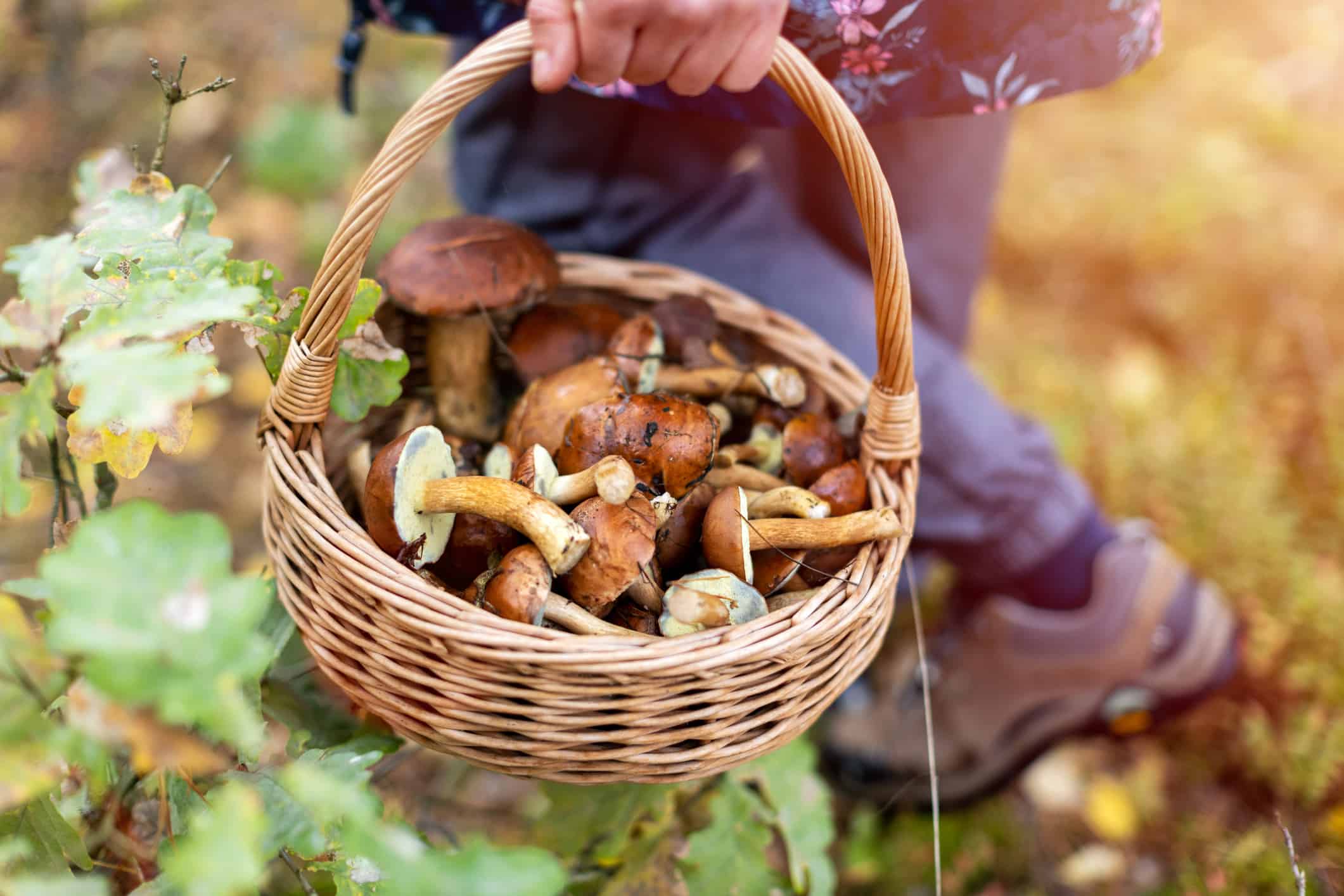
The number one rule for picking mushrooms – when in doubt, throw it out.
©iStock.com/PIKSEL
The first thing to understand about mushrooms is that they won’t harm your lawn. Different types of lawn mushrooms can actually be kind of useful. They aid in the decomposition of organic matter, which enriches the soil. However, many lawn enthusiasts are not fans of the way they protrude their tiny, umbrella-like heads all over the grass.
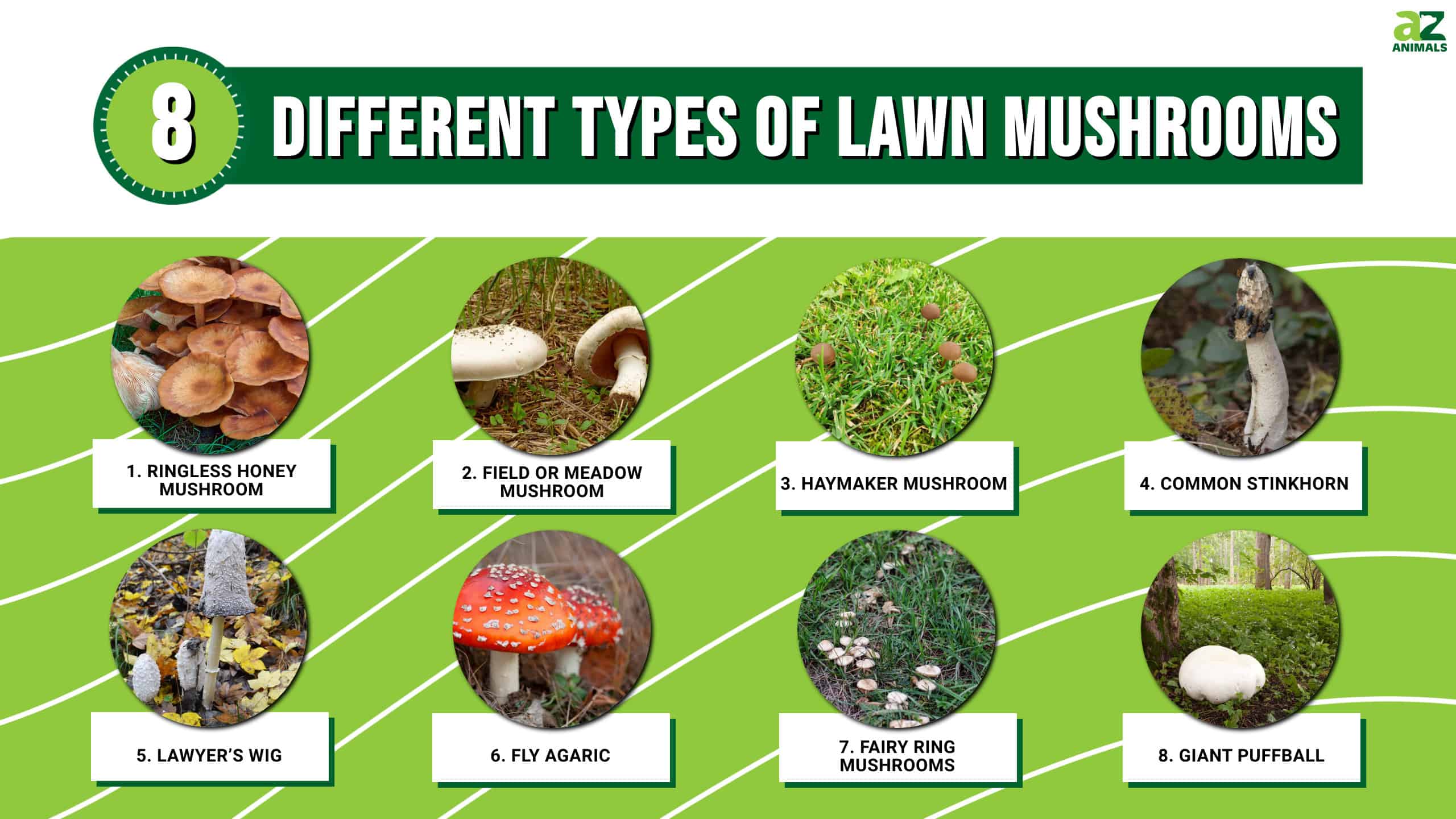
Additionally, certain mushrooms are toxic and dangerous for kids and animals. Below you’ll find the top eight most common mushrooms found in lawns across the world! We’ll go over what they look like if they’re poisonous, if they’re edible, and a few fun facts about each type!
1. Ringless Honey Mushroom
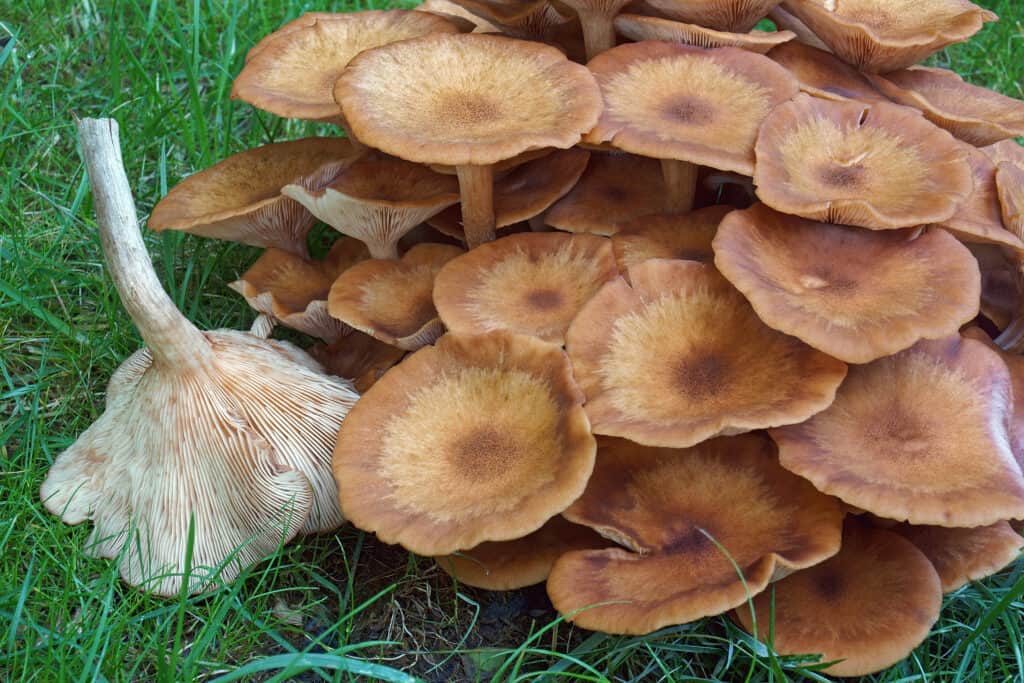
Clusters of Ringless Honey Cluster Mushrooms often grow on wood and tree stumps.
©iStock.com/nickkurzenko
You might discover ringless honey mushrooms in your yard growing on oak tree stumps or tree trunks. These edible mushrooms grow 2 to 8 inches tall and 1 to 4 inches wide. You may typically find these mushrooms blooming from September through November.
As their name says, they have a gold cap that resembles honey. Ringless honey mushrooms can damage trees by blocking them from collecting water and nutrients, so if you see any in your yard, get rid of them even though fungi can be a vital part of ecosystems. The Eastern United States is where they are primarily found.
2. Field or Meadow Mushroom
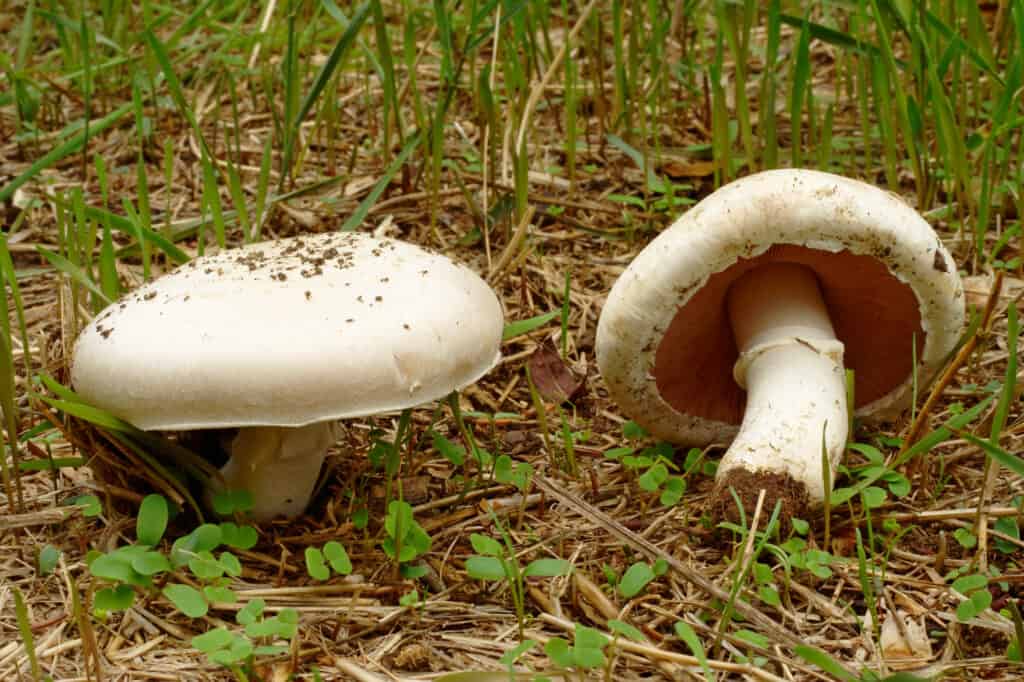
Field Mushrooms are edible, but they can easily be confused with other highly toxic and dangerous mushrooms.
©iStock.com/fedsax
The field or meadow mushroom is one of the most popular wild mushrooms in Great Britain and Ireland. It has a similar flavor and texture to the ordinary button mushroom and is closely linked to it. In fields, meadows, and lawns, you can see them developing singly or in groups, as arcs or gradually widening rings known as fairy rings.
With a cap that is creamy-white and 1 to 4 inches in diameter, when this mushroom is fully grown, the edges of the caps typically stay downturned or curled inward. When the cap is sliced, the flesh should be dense and white, occasionally turning just a little pink, but never yellow.
Comparable to portobellos, as the mushroom ages, the gills turn from a deep pink to a brown and then to a dark brown color. You could mistake various kinds of mushrooms for field mushrooms; some of them are edible, while others are harmful.
3. Haymaker Mushroom
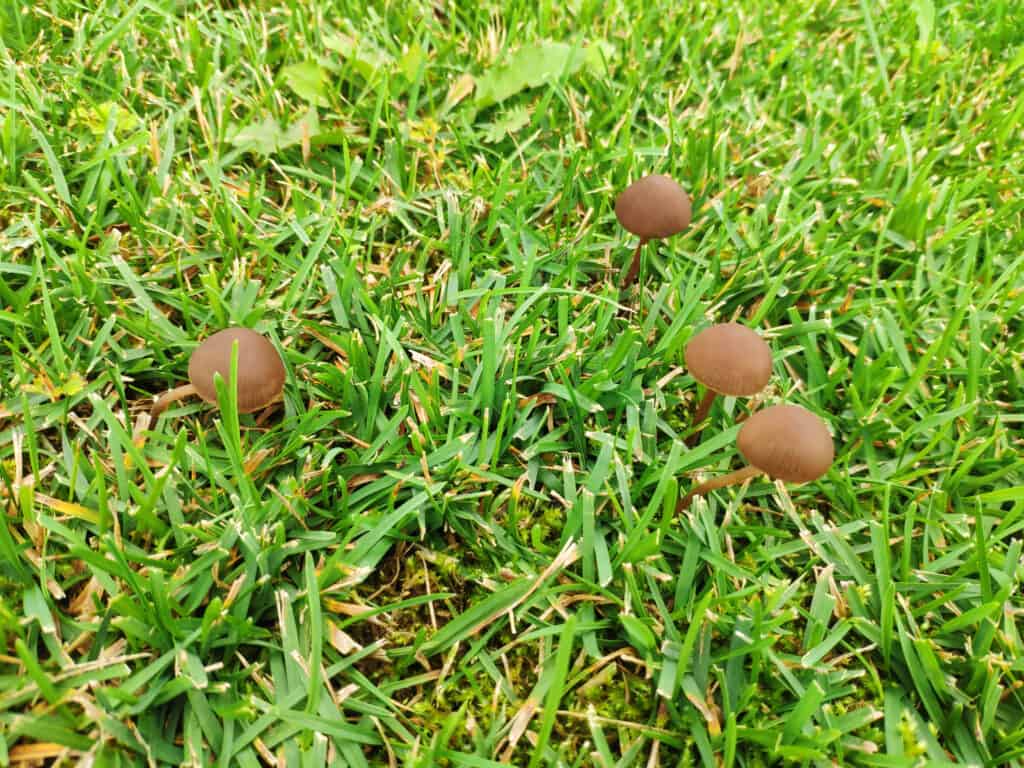
Haymaker Mushrooms are commonly found growing in lawns, but they are not edible.
©iStock.com/Anna Kanishcheva
There are numerous names for this mushroom, including haymakers, mowers, lawnmowers, and brown hay mushrooms. This small brown mushroom, which is widespread in lawns across North America and Europe, is inedible but not dangerous. Surprisingly, these mushrooms may swiftly take over your home, and they love routinely manicured lawns.
These mushrooms have tops that are less than 1.5 inches wide and range in height from 1 to 3 inches. There are Haymaker mushrooms in both Europe and North America, especially in the Pacific Northwest. Steer clear, because these mushrooms aren’t edible.
4. Common Stinkhorn
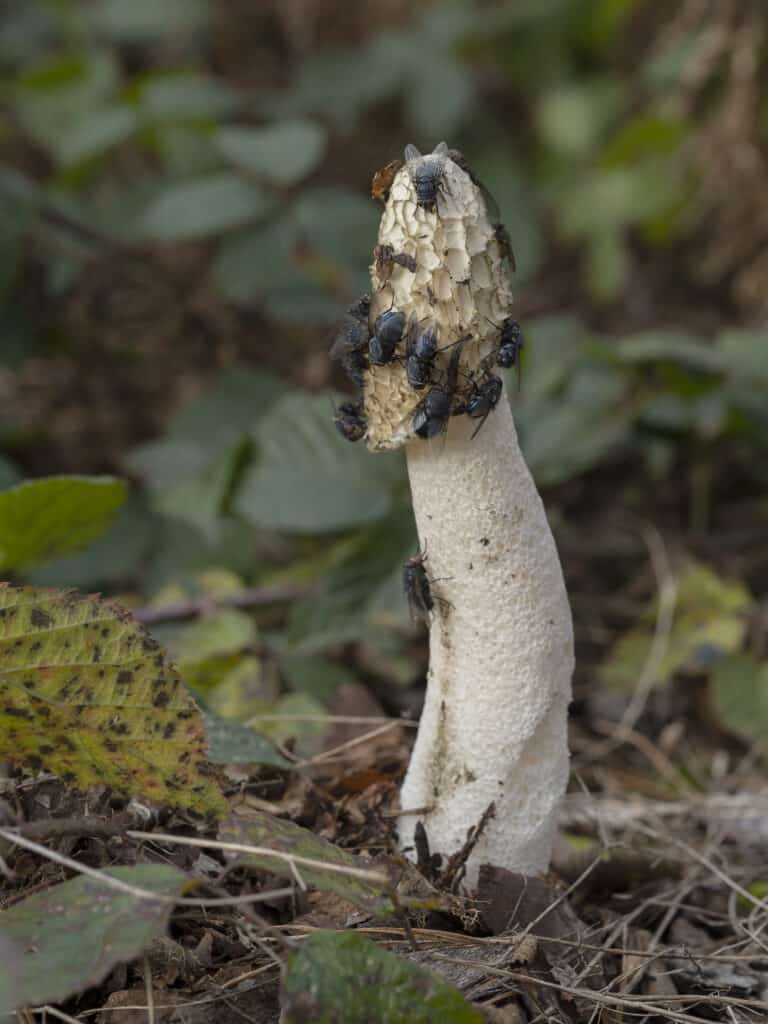
Common Stinkhorn Mushrooms grow in wooded areas and in gardens with mulch.
©iStock.com/MikeLane45
One of the strangest of the different types of lawn mushrooms you may come across is the common stinkhorn mushroom. The common stinkhorn belongs to a group of many stinkhorn species that are distinguished by their unpleasant scent and, when fully grown, their phallic shape. Between the summer and the late fall, they are widespread in Britain, Ireland, Europe, and North America.
Where there is a lot of woody organic matter, such as in woodlands and mulched gardens, you can find these mushrooms growing. A foul, olive-green substance called a “gleba” surrounds the cap and the spores of a stinkhorn when it first appears. They emit a potent odor that has been compared to that of decaying meat, luring insects that disperse the spores.
Despite their unpleasant odor, they are typically not toxic. People in some nations consume young stinkhorns, sometimes known as “eggs” due to their resemblance to eggs. Pets are drawn to them because of their odor, but there have also been stories of small dogs becoming seriously ill after eating mature stinkhorns.
5. Lawyer’s Wig
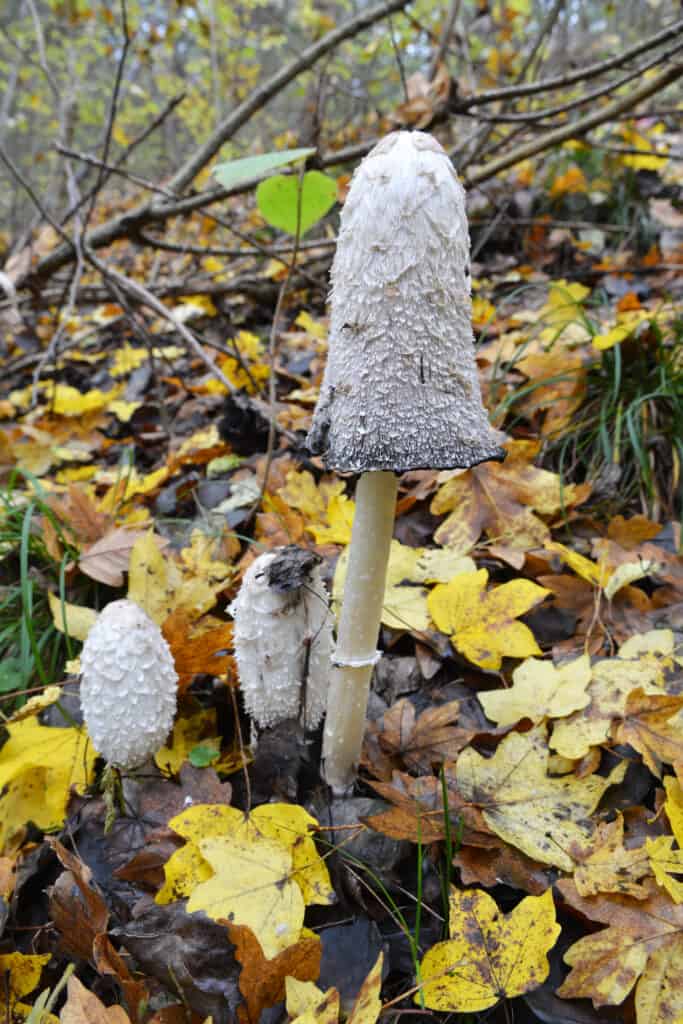
Shaggy Ink Cap Mushrooms decompose quickly and should be eaten soon after they are picked.
©iStock.com/Orest Lyzhechka
The lawyer’s wig mushroom, also known as shaggy mane or fuzzy ink cap, is a type of lawn mushroom that will stand tall amid grass blades. When prepared to release its spores or plucked, it begins as a long, white mushroom but rapidly shrivels from the bottom up and turns deep black. This means that in order to prepare this tasty fungus, you must act swiftly before things become messy.
Lawyer’s wig mushrooms have a 2 to 8-inch height and width range. This type of mushroom is common across North America and Europe. Dig in, because lawyer’s wig mushrooms are edible!
It’s important to keep in mind that some mushrooms from the same family as lawyer’s wig mushrooms don’t interact very well with alcohol and can even cause moderate poison when combined.
6. Fly Agaric
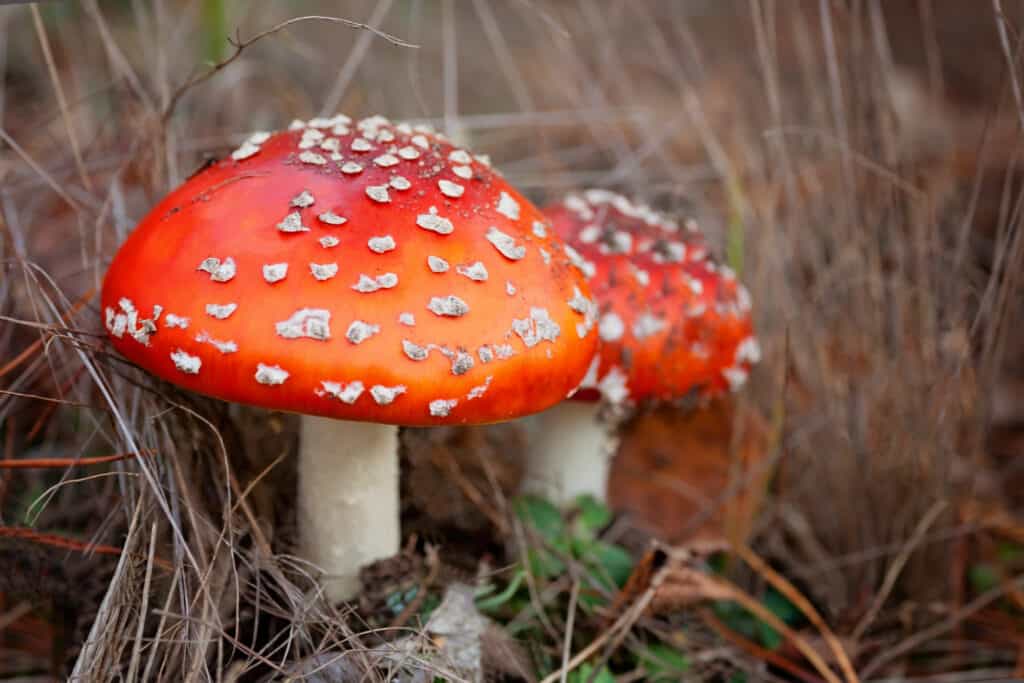
The Fly Agaric Mushroom is commonly used to represent mushrooms in cartoons and video games.
©iStock.com/aletheia97
The fly agaric mushroom is what most people think of when you say the word “toadstool.” This enormous mushroom is readily identified by its red or yellow cap and white stem, gills, and cap scales. Despite being regarded as toxic, there haven’t been many cases of poisoning from eating this fungus; instead, it’s more of a narcotic or hallucinogenic mushroom.
Fly agarics are remarkable because, although dangerous, people in some nations eat them. To lessen the toxicity prior to eating them, you must continually boil them, but even then, they may still make you unwell.
7. Fairy Ring Mushrooms
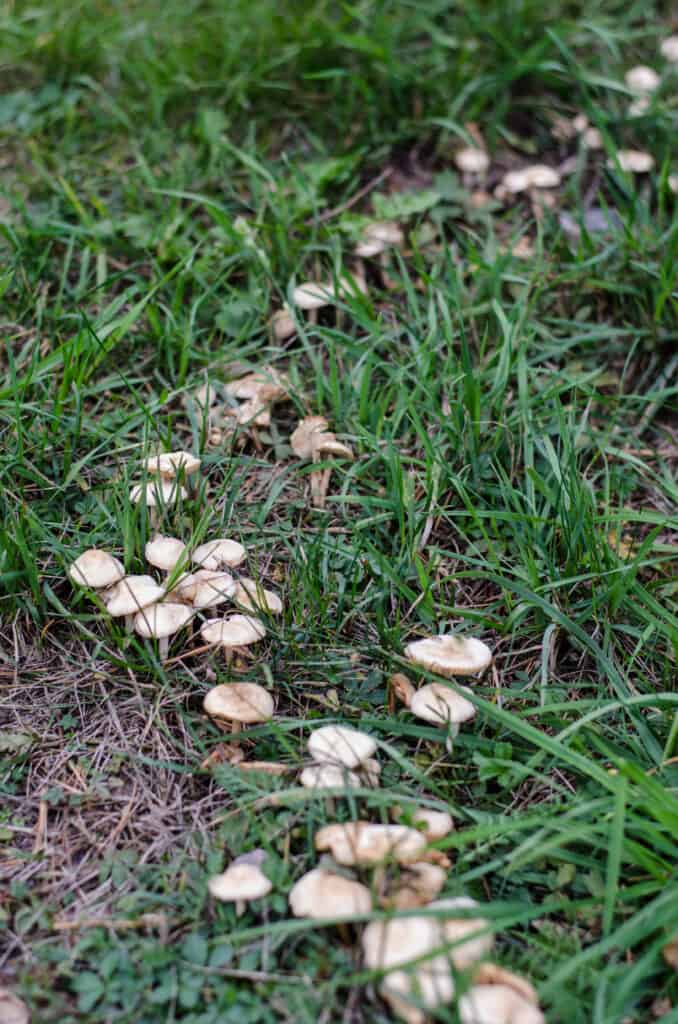
Mushrooms like
Marasmius oreadesoften grow together in arcs or circles, which has inspired many stories in mythology and folklore.
©iStock.com/ariJ
Depending on your point of view, “fairy rings” can either be a regular lawn issue or a fantastic experience. Moist, nutrient-rich lawns are where these mushroom rings appear. Fairy ring mushrooms (Marasmius oreades) are a frequent species involved in this occurrence, though fairy rings can be made up of dozens of other kinds of mushrooms as well.
All around Europe and North America, these mushrooms could start to appear on lawns. Not all mushrooms that appear in fairy rings are edible, though Marasmius oreades are. This species can reach heights of 0.75 to 3 inches, with caps that are 0.4 to 2 inches wide. Fairy rings, the circles of these mushrooms that are encroaching on your lawn, can have a diameter of up to 15 feet. In many European fairytales, fairy rings are seen as a sign of magic.
8. Giant Puffball
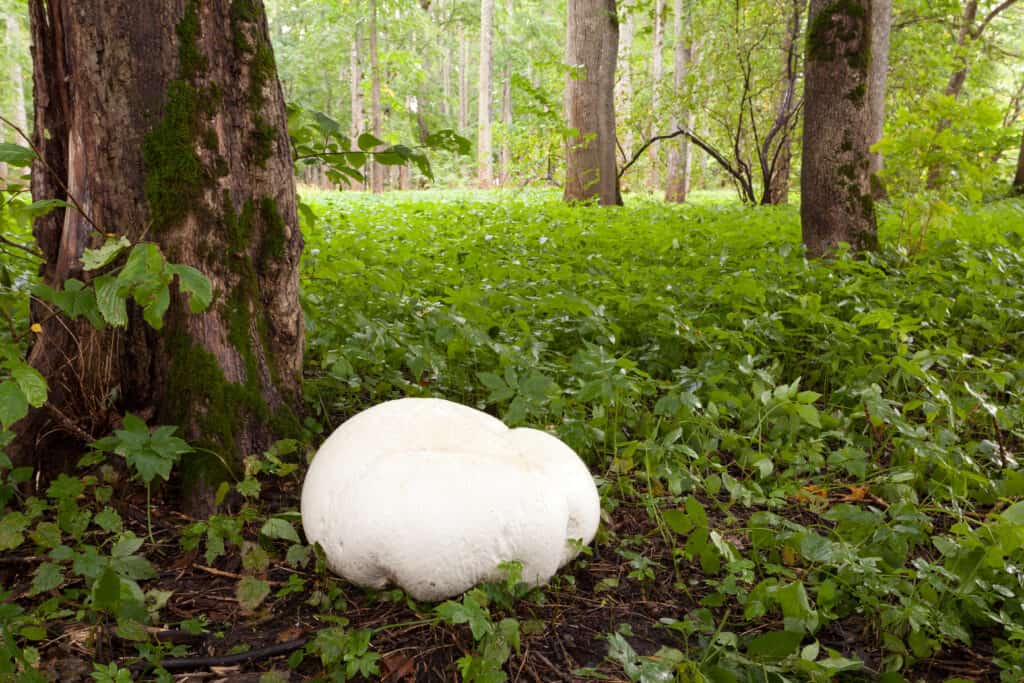
The best way to tell the difference between giant puffball mushrooms and other poisonous species is to cut the mushroom open.
©iStock.com/geoleo
One of the largest types of lawn mushrooms you might see is the Giant Puffball or Calvatia Gigantea. This mushroom grows all throughout North America and other temperate areas of the world. It grows to heights of 3 to 12 inches and widths of 8 to 24 inches.
Puffballs are a type of fungus that develop as solid spheres devoid of any gills, crowns, or stems. Although some individuals are fortunate enough to have enormous giant puffballs on their lawns, a few of the most typical backyard mushrooms are smaller species of puffballs up to 2 inches (5 cm) in size.
Puffballs come in a variety of species, and they are all edible when juvenile and have a white interior. It’s important to correctly recognize juvenile puffball mushrooms before eating them since many toxic fly agaric or Amanita mushrooms resemble puffballs in their early stages of development.
Cut your suspected puffball in half to make sure you have the appropriate mushroom. The internal tissue ought to be solidly white, firm, and thick. Throw away the mushroom if the interior has a mushroom form, gills, or any other black, brown, yellow, or purple coloring.
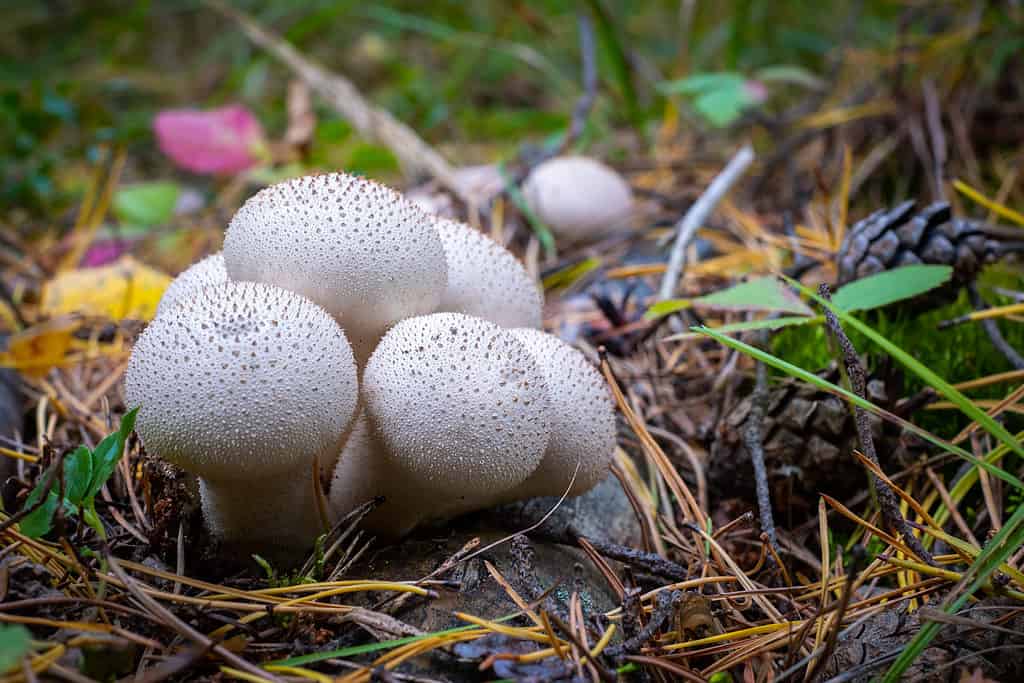
Common puffball (Lycoperdon perlatum) mushrooms.
©Andrei Ksenzhuk/Shutterstock.com
Should You Keep Mushrooms in Your Yard?
Although a new species might excite wildlife gardeners, many lawn owners moan when they notice mushrooms growing in the midst of their lawn. Unfortunately, I have some unwelcome news if you don’t want mushrooms in your backyard: it’s quite difficult to get rid of them.
In damp, shaded environments, fungi produce mushrooms. Technically, a homeowner could completely remove all shade and stop watering their lawn, and presto! It would produce fewer mushrooms. Due to the fact that mushrooms are not plants, herbicides have no effect on them. Although fungicides are available, employing them can only temporarily get rid of the many different types of lawn mushrooms.
Many plants wouldn’t be able to live in your backyard if you were crafty enough to get rid of the fungus. The presence of fungi is necessary for all productive soil. They decompose organic materials to provide nutrients that plants like tomatoes or turf grasses can use to grow and develop. The next time you notice mushrooms in your lawn producing fruit, consider it a necessary stage of their life cycle that is beneficial for the health of your yard.
Most Poisonous Mushroom
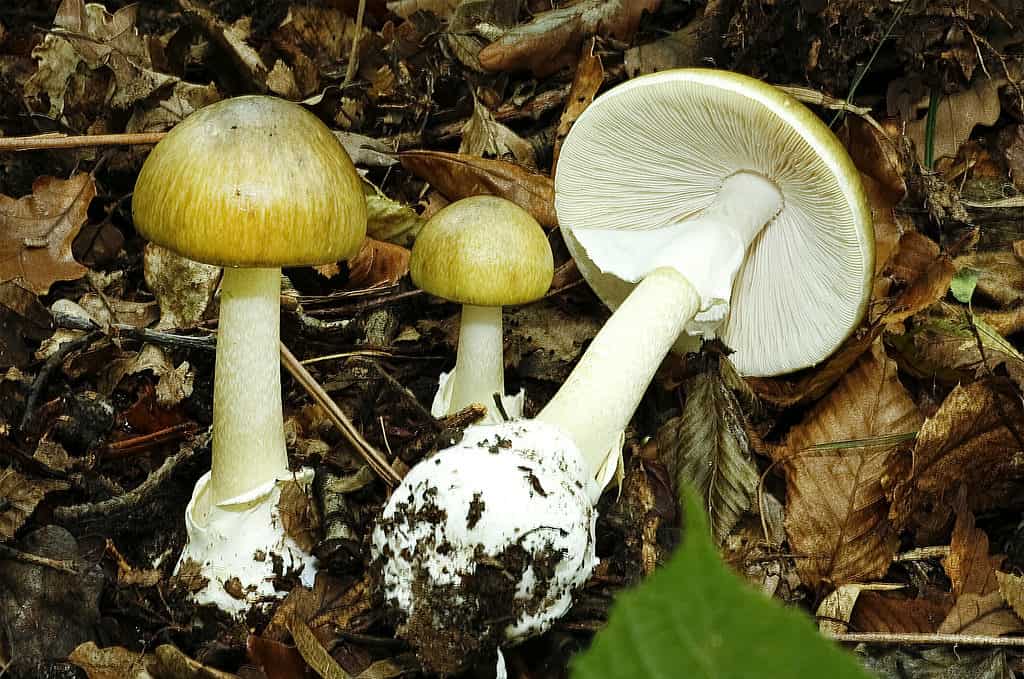
Amanita phalloides aka death cap is the most poisonous mushroom.
©el_cigarrito/Shutterstock.com
The earth’s most toxic mushroom, the death cap (Amanita phalloides), used to be found only in Europe but hitched a ride with imported trees and can now be found worldwide. These ordinary-looking mushrooms look innocent enough, but these nightmarish fungi are responsible for more than 90% of all mushroom poisonings and fatalities around the globe. Eating just half a cap is enough to kill a person. As soon as six hours after eating a death cap, dehydration, abdominal pain, vomiting, and diarrhea begin. The symptoms subside for a day or two – then organs begin to shut down, bringing on seizures, coma, and death. Even if a person gets treatment in time, they usually need a kidney or liver transplant. Don’t eat these mushrooms!
Bonus: Mushrooms Are Frequently Used in Asian Medicine
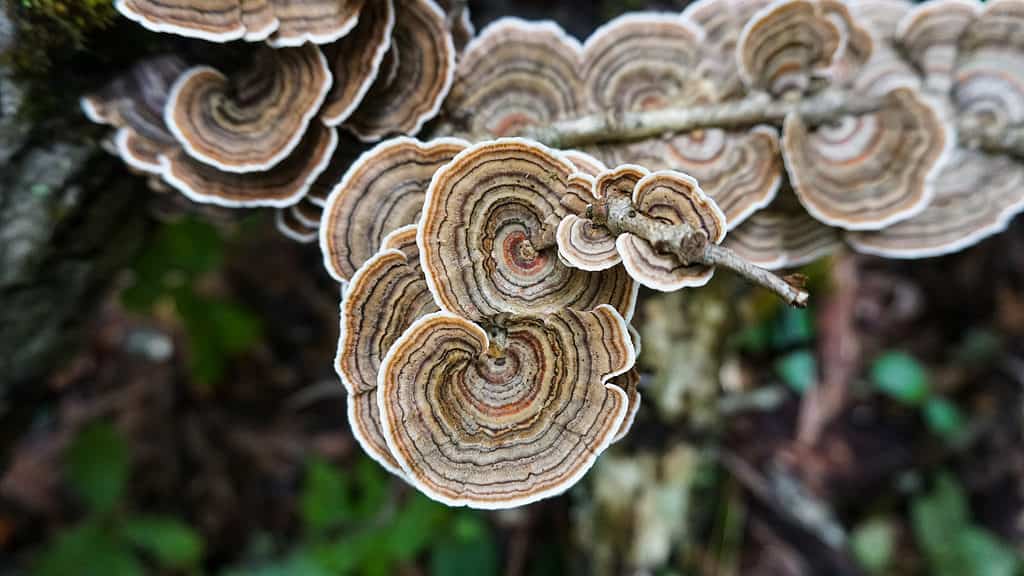
Turkey tail fungus has been used in traditional Chinese medicine for years.
©James Aloysius Mahan V/Shutterstock.com
Medicinal mushrooms have been used to treat infection for hundreds of years in Asian countries. They have been used in cancer treatments in Japan and China for the last 30 years – often in combination with radiation and chemotherapy. There are many types of mushrooms that are used for medicinal purposes in Asia – but one type, the turkey tail, may show more promise than any other.
Turkey tail (Trametes versicolor or Coriolus versicolor) is a type of mushroom that grows on dead logs all over the world. Its round rings resemble the tail feathers of a turkey or a roof tile – as it is called roof-tile fungus in Japan. Turkey tail has been used to treat lung diseases in China for many years and is used in Japan to strengthen the immune system during cancer treatments.
The active compound found in turkey tail is Polysaccharide K, or PSK – and is approved in some Asian countries to treat cancer. Patients either drink PSK in tea or take it in capsule form. Studies show that the compound in turkey tail does indeed strengthen the immune system. Nature provides relief for many things that ail us – as the use of this humble mushroom in medicine demonstrates.
The photo featured at the top of this post is © iStock.com/Dan Fog Madsen
The information presented on or through the Website is made available solely for general informational purposes. We do not warrant the accuracy, completeness, or usefulness of this information. Any reliance you place on such information is strictly at your own risk. We disclaim all liability and responsibility arising from any reliance placed on such materials by you or any other visitor to the Website, or by anyone who may be informed of any of its contents. None of the statements or claims on the Website should be taken as medical advice, health advice, or as confirmation that a plant, fungus, or other item is safe for consumption or will provide any health benefits. Anyone considering the health benefits of particular plant, fungus, or other item should first consult with a doctor or other medical professional. The statements made within this Website have not been evaluated by the Food and Drug Administration. These statements are not intended to diagnose, treat, cure or prevent any disease.
Thank you for reading! Have some feedback for us? Contact the AZ Animals editorial team.



